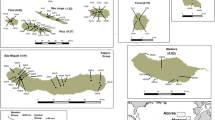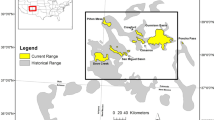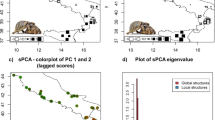Abstract
Microsatellite DNA was used to investigatelevels of genetic variability in severelyfragmented populations of the geometrictortoise, Psammobates geometricus, themost endangered tortoise on mainland Africa.Eight microsatellite markers were used toassess genetic variability within and betweenthree naturally occurring populations of P. geometricus. These populations areseparated by the Cape Fold mountain ranges inthe western Cape region of South Africa. Levels of variability were quantified usingallelic diversity, genotypic frequencies andheterozygosity. Evidence for populationsub-structuring was examined using Fstatistics, Rst and δμ2.High levels of variability were found in allthree populations. Low levels of populationdifferentiation were found suggestingsignificant gene flow between the populations.
Similar content being viewed by others
References
Baard EHW (1992) Morphometric and stripe pattern differences between geometric tortoise (Psammobates geometricus) populations in the South-Western Cape Province. African Herpetology News, 18, 15–20.
Baard EHW, Mouton Ple FN (1993a) A hypothesis explaining the enigmatic distribution of the geometric tortoise, Psammombates geometricus, in South Africa. Herpetological Journal, 3, 65–67.
Baard EHW (1993b) Distribution and status of the geometric tortoise, Psammombates geometricus, in South Africa. Biological Conservation, 63, 235–239.
Baard EHW (1995a) A preliminary analysis of the habitat of the geometric tortoise. Psammobates geometricus, South African Journal Wildlife Research, 25(1), 8–13.
Baard EHW (1995b) Growth, age at maturity and sexual dimorphism in the geometric tortoise, Psammobates geometricus. Journal Herpetological Association of Africa, 44, 10–15.
Banks MA, Eichert W (2000) WHICHRUN (Version 3.2) a computer programme for population assignment of individuals based on multilocus genotype data. Journal of Heredity, 91, 87–89.
Boycott RC, Bourquin O (1988) The South African tortoise book. Johannesburg: Southern Book Publishers (PTY) Ltd.
Broders HG, Mahoney SP, Montevecchi WA, Davidson WS (1999) Population genetic structure and the effect of founder events on the genetic variability of moose, Alces alces. Molecular Ecology, 8, 1309–1315.
Bruford MW, Wayne RK (1993) Microsatellites and their application to population genetic studies. Current Opinions in Genetics and Development, 3, 939–943.
Cowling RM, Richardson D (1995) Fynbos – South Africa's Unique Floral Kingdom. Fernwood Press, Cape Town.
Frankel OH, Soulé ME (1981) Conservation and Evolution. Cambridge University Press, Cambridge.
Frankham R, Ralls K (1998) Inbreeding leads to extinction. Nature, 392, 441–442.
Garza JC, Williamson EG (2001) Detection of reduction in population size using data from microsatellite loci. Molecular Ecology, 10, 305–318.
Goldstein DB, Linares AR, Cavalli-Sforza LL, Feldman MW (1995) An evaluation of genetic distances for use with microsatellite loci. Genetics, 139, 463–471.
Goodman SJ (1997) RstCalc: A collection of computer programmes for calculating estimates of genetic differentiation from microsatellite data and determining their significance. Molecular Ecology, 6, 881–885.
Goudet J (1995) FSTAT, version 1.2 a computer programme to calculate Fstatistics. Journal of Heredity, 86, 485–486.
Greig JC, Boycott RC (1977) The geometric tortoise – Psammobates geometricus – Progress Report 1977. In Research Report – Herpetology, 1977, 56–66. Cape Department of Nature and Environmental Conservation, Cape Town.
Groombridge B (ed.) (1993) 1994 IUCN Red List of Threatened Animals. IUCN, Gland.
Guo SW, Thompson EA (1992) Performing the exact test of Hardy-Weinberg proportion for multiple alleles. Biometrics, 48, 361–372.
Harley EHH (2001) Agarst version 2.2. University of Cape Town, South Africa.
Iverson JB (1992) A Revised Checklist with Distribution Maps of the Turtles of the World. Privately printed, Richmond, Indiana.
Juvik JO (1971) The status of Psammobates geometricus in the Western Cape. International. Turtle and Tortoise Society Journal, 5(1), 10–13.
Kimura M, Crow JF (1964) The number of alleles that can be maintained in a finite population. Genetics, 49, 561–576.
Kimura M, Ohta T (1978) Stepwise mutation model and distribution of allele frequencies in a finite population. Proceedings of the National Academy of Science, USA, 75, 2868–2872.
Lehmann T, Hawley WA, Grebert H, Collins FH (1998) The effective population size of Anopheles gambiae in Kenya: Implications for population structure. Molecular Biology and Evolution, 15(3), 264–276.
Luikart G, Cornuet J (1998) Emperical evaluation of a test for identifying recently bottlenecked populations from allele frequency data. Conservation Biology, 12(1), 228–237.
Lundy CJ, Moran P, Rico C, Milner RS, Hewitt GM (1999) Macrogeographical population differentiation in oceanic environments: A case study of European hake (Merluccius merluccius), a commercially important fish. Molecular Ecology, 8, 1889–1898.
McDowell C, Moll E (1992) The influence of agriculture on the decline of West Coast Renosterveld, south-western Cape, South Africa. Journal of Environmental Management, 35, 173–192.
Moritz C (1994) Defining evolutionary significant units for conservation. Trends in Ecolology and Evolution, 9, 373–375.
Nei M (1973) Analysis of gene diversity in sub-divided populations. Proceedings of the National Academy of Sciences USA, 70, 3321–3323.
O'Ryan C, Harley EH, Bruford MW, Beaumont M, Wayne RK, Cherry MI (1998) Microsatellite analysis of genetic diversity in fragmented South African buffalo populations. Animal Conservation, 1, 85–94.
Pemberton JM, Slate J, Bancroft DR, Barrett JA (1995) Nonamplifying alleles at microsatellite loci: A caution for parentage and population studies. Molecular Ecology, 4, 249–252.
Piry S, Luikart G, Cornuet JM(1999) BOTTLENECK 1.2.02: A programme for detecting recent effective population size reductions from allele frequencies. Available at http://www.ensam.inra.fr/ URLB.
Primack RB (1993) Essentials of Conservation Biology. Sinauer Associates, Sunderland, Massachusetts.
Rau R (1971) Cape Reserve for one of the world's rarest tortoises. African Wildlife, 25(3), 96.
Raymond M, Rousset F (1995) GENEPOP (version 1.2): Population genetic software for exact tests and Ecumericism. Journal of Hereditary, 3, 248–249.
Rice WR (1989) Analysing tables of statistical tests. Evolution, 43, 223–225.
Roff DA, Bentzen P (1989) The statistical analysis of mitochondrial DNA polymorphisms: Chi-squared and the problem of small samples. Molecular Ecology and Evolution, 6, 539–545.
Rooney AP, Honeycutt RP, Davis SK, Derr JN (1999) Evaluating a Putative Bottleneck in a Population of Bowhead Whales from Patterns of Microsatellite Diversity and Genetic Disequilibria. Journal of Molecular Evolution, 49(4), 682–690.
Saccheri I, Kuusaari M, Kankare M (1998) Inbreeding and extinction in a butterfly population. Nature, 392, 491–494.
Sambrook J, Fritsch EF, Maniatis T (1989) Molecular cloning: A labarotory manual, 2nd edn. Cold Spring Harbor Laboratory press, New York.
Sites JW, Fitzsimmons NN, Jorge Da Silva N, Cantarelli VH (1999) Conservation genetics of the Giant Amazon River Turtle (Podocnemis expansa) – inferences from two classes of molecular markers. Chelonian Conservation and Biology, 3(3), 454–463.
Slatkin M (1995) A measure of population subdivision based on microsatellite allele frequencies. Genetics, 139, 457–462.
Swofford DL, Selander RB (1981) BIOSYS-1: A FORTRAN program for the comprehensive analysis of electrophoretic data in population genetics and systematics. Journal of Heredity, 72, 281–283.
Tautz D, Rens M (1984) Simple sequences are ubiquitous repetitive components of eukaryotic genomes. Nucleic acids Research, 12.
Weir BS, Cockerham CC (1984) Estimating F-statistics for the analysis of population structure. Evolution, 38, 1358–1370.
Westemeier RL, Brawn JD, Simpson SA, Esker TL, Jansen RW, Walk JW, Kershner EL, Bouzat JL, Paige KN (1998) Tracking the long term decline and recovery of an isolated population. Science, 282, 1695–1698.
Young Ag, Merriam HG, Warwick SI (1993) The effects of forest fragmentation on genetic variation in Acer saccharum Marsh (sugar maple) populations. Heredity, 71, 227–289.
Author information
Authors and Affiliations
Corresponding author
Rights and permissions
About this article
Cite this article
Cunningham, J., Baard, E., Harley, E. et al. Investigation of genetic diversity in fragmented geometric tortoise (Psammobates geometricus) populations. Conservation Genetics 3, 215–223 (2002). https://doi.org/10.1023/A:1019909515202
Issue Date:
DOI: https://doi.org/10.1023/A:1019909515202




